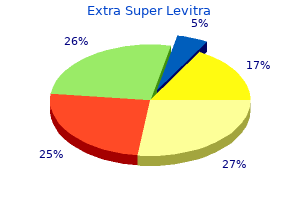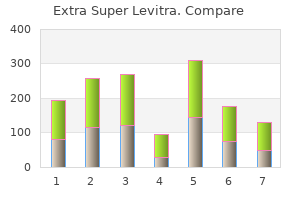Extra Super Levitra
"Cheap extra super levitra 100mg otc, erectile dysfunction natural supplements".
By: X. Sigmor, M.B.A., M.B.B.S., M.H.S.
Assistant Professor, Texas Tech University Health Sciences Center School of Medicine
People with diabetes and their caregivers must consider each of these risk factors when the problem of iatrogenic hypoglycemia is recog- 535 Part 6 Treatment of Diabetes nized erectile dysfunction treatment ring order extra super levitra 100mg amex. A history of severe hypoglycemia indicates erectile dysfunction disorder order extra super levitra 100 mg on-line, and that of hypoglycemia unawareness implies erectile dysfunction drugs walgreens 100 mg extra super levitra visa, recent antecedent hypoglycemia erectile dysfunction and heart disease cheap extra super levitra 100mg on line. That does not mean that one cannot both improve glycemic control and minimize the risk of hypoglycemia [1,2,47] as discussed below. It has been estimated that its prevalence will rise from 285 million people in the year 2009 to 435 million people by the year 2030 [61]. Indeed, because it precludes maintenance of euglycemia over a lifetime of diabetes, the barrier of hypoglycemia ultimately affects all people with diabetes [1,2]. The average patient has untold numbers of episodes of asymptomatic hypoglycemia and experiences two episodes of symptomatic hypoglycemia per week thousands of such episodes over a lifetime of diabetes and one or more episodes of severe, temporarily disabling hypoglycemia, often with seizure or coma, per year. An incidence comparable to the latter was also found in a large observational study [55]. Evaluation and management of adult hypoglycemic disorders: an Endocrine Society clinical practice guideline. Because asymptomatic episodes will almost invariably be missed, symptomatic episodes may not be recognized as the result of hypoglycemia [81] and, even if they are, they are not long remembered [82,83], estimates of the frequency of iatrogenic hypoglycemia are underestimates. Although they represent only a small fraction of the total hypoglycemic experience, because they are dramatic events that are more likely to be reported (by the patient or an associate) [82,83], estimates of the frequency of severe hypoglycemia, requiring the assistance of another person, are more reliable, particularly if they are determined in population-based prospective studies that include a focus on hypoglycemia [1,2]. The psychologic morbidity includes fear of hypoglycemia [89], which can be a barrier to glycemic control. Three early reports indicated that 24% of people with diabetes die from hypoglycemia [9092]. It could have been the result of a non-glycemic effect of the intensive therapy regimen. Although symptoms typically develop at a plasma glucose concentration of approximately 5055 mg/dL (2. Within the error of self-monitoring of blood glucose (or continuous glucose sensing), that conservative alert value approximates the lower limit of the non-diabetic post-absorptive plasma glucose concentration range [11] and the normal glycemic thresholds for activation of physiologic glucose counter-regulatory systems [11], and is low enough to reduce glycemic defenses against subsequent hypoglycemia Impact of hypoglycemia Iatrogenic hypoglycemia causes recurrent physical and psychologic morbidity, and some mortality, impairs defenses against subsequent hypoglycemia and precludes maintenance of euglycemia over a lifetime of diabetes [1,2]. In the short-term it causes brain fuel deprivation that, if unchecked, results in functional brain failure that is typically corrected after the plasma glucose concentration is raised [4]. Rarely, it causes sudden, presumably cardiac arrhythmic [84,85], death or, if it is profound and prolonged, brain death [4]. The physical morbidity of an episode of hypoglycemia ranges from unpleasant symptoms to seizure and coma [1,2,4]. Nonetheless, the possibility that it does so in young children remains [87,88], and there are no corresponding 537 Part 6 Treatment of Diabetes Table 33. Severe hypoglycemia An event requiring assistance of another person to administer actively carbohydrate, glucagon or other resuscitative actions. Plasma glucose measurements may not be available during such an event, but neurologic recovery attributable to the restoration of plasma glucose to normal is considered sufficient evidence that the event was induced by a low plasma glucose concentration Documented symptomatic hypoglycemia An event during which typical symptoms of hypoglycemia are accompanied by a measured plasma glucose concentrations 70 mg/dL (3. It also generally provides some margin for the relative inaccuracy of glucose monitors at low plasma glucose concentrations [102]. The use of this plasma glucose cutoff value, compared with lower values, will result in higher frequencies of hypoglycemia, and a greater proportion of episodes that are asymptomatic. The recommended generic alert value does not mean that people with diabetes should always treat for hypoglycemia at an estimated plasma glucose concentration of 70 mg/dL (3. Rather, it indicates that they should consider actions ranging from repeating the measurement in the nearterm through behavioral changes such as avoiding exercise or driving without treatment to carbohydrate ingestion and subsequent regimen adjustments. Prevention and treatment of hypoglycemia in diabetes Prevention of hypoglycemia: hypoglycemia risk factor reduction Iatrogenic hypoglycemia is a barrier to glycemic control in people with diabetes [1,2], but that barrier can be lowered in individual patients with diabetes by the practice of hypoglycemia risk factor reduction (Table 33. That involves four steps: 1 Acknowledge the problem; 2 Apply the principles of aggressive glycemic therapy [1,2,47,103107]; 3 Consider the conventional risk factors for hypoglycemia (Table 33. The issue of hypoglycemia should be addressed in every contact with people with diabetes, at least those treated with an insulin secretagogue or with insulin [1,2,47]. Acknowledging the problem allows the caregiver either to move on if hypoglycemia is not an issue or to address it, and keep it in perspective, if hypoglycemia is an issue. Patient concerns about the reality, or even the possibility, of hypoglycemia can be a barrier to glycemic control [108,109].

Insurance · Diabetes should be declared to insurers male erectile dysfunction pills order extra super levitra american express, who may impose higher premiums or limited coverage erectile dysfunction drugs from canada order extra super levitra without prescription. National diabetes organizations can provide details of insurance brokers who do not weight policies against people with diabetes erectile dysfunction treatment pumps 100 mg extra super levitra. As the latter is a major determinant of survival impotence losartan buy extra super levitra in india, life insurance premiums should be reduced for all those who reach the age of 50 years without renal impairment. Alcohol · the association between excessive alcohol consumption, chronic pancreatitis and secondary diabetes is well established. Alcohol excess is also associated with central obesity and poor compliance with medication; both could increase the risk of type 2 diabetes and compromise control of established diabetes. Most epidemiologic studies, however, have demonstrated a U-shaped relationship between alcohol consumption and diabetes, with moderate intake being associated with a lower risk of diabetes. Excessive alcohol consumption is associated with hypertriglyceridemia and resistant hypertension; affected individuals have an increased vascular risk. Alcohol obscures the ability, both of the individual and of observers, to recognize and treat hypoglycemia, and intoxication can simulate hypoglycemia. Recreational drugs · Approximately one-third of young people with diabetes use recreational drugs at some time. Intravenous drug use is uncommon but is dangerous and is associated with omission of insulin therapy, frequent hospital admissions (usually with diabetic ketoacidosis) and high mortality. In addition to an increased risk of cardiac arrhythmias and myocardial ischemia, the sympathetic activation antagonizes the action of insulin and can precipitate diabetic ketoacidosis. Travel · Diabetes is not a bar to traveling, but changes in meals, physical activity and antidiabetic drug treatment en route and after arrival all need careful consideration. Important issues include travel insurance, medical identification, supplies and storage of medication and monitoring equipment and immunizations. Insulin injection schedules may require in-flight adjustment, especially if the time-shift exceeds 4 hours. Diabetes influences many aspects of daily life, principally through the effects of treatment and its potential side effects, particularly hypoglycemia. The development of diabetic complications, such as neuropathy and retinopathy, can also affect everyday activities, particularly when these are severe with clinical manifestations, or require time-consuming treatment such as dialysis for chronic renal failure. Newly diagnosed people with diabetes, especially insulin-treated, should not drive until glycemic control and vision are stable Recurrent daytime hypoglycemia (particularly if severe) Impaired awareness of hypoglycemia, if disabling Reduced visual acuity in both eyes (worse than 6/12 on Snellen chart) note use of mydriatics for eye examination will affect visual acuity Severe sensorimotor peripheral neuropathy, especially with loss of proprioception Severe peripheral vascular disease Lower limb amputation Driving Driving is an everyday activity that demands complex psychomotor skills, visuospatial coordination, vigilance and satisfactory judgment. Diabetes is designated a "prospective disability" for driving because of its potential to progress and cause complications, while side effects of treatment (principally hypoglycemia) can affect driving performance. In most countries, the duration of the license of a driver with diabetes is period-restricted by law, and its renewal is subject to review of medical fitness to drive. The problems associated with diabetes and driving and the limitations of relevant research data have been reviewed [1,2]. The main problems for the driver with diabetes are hypoglycemia and visual impairment resulting from cataract or retinopathy. Rarely, peripheral neuropathy, peripheral vascular disease and lower limb amputation can present mechanical difficulties with driving (Table 24. Despite these challenges, drivers with diabetes do not appear to be involved in more accidents than their non-diabetic coun- terparts [3]. In most surveys, however, incidents were self-reported and probably underestimated, while fatal accidents (in which a diabetes-related cause, such as hypoglycemia, could have had a role) were excluded. Accident rates may also have been lowered by regulatory authorities barring high-risk drivers and by drivers with advancing diabetic complications who voluntarily stop driving [4,5]. Hypoglycemia Drivers with insulin-treated diabetes often experience hypoglycemia while driving [4,5,11] and this can interfere with driving 381 Part 5 Managing the Patient with Diabetes Table 24. Hypoglycemia is a recognized cause of road traffic accidents, but its true frequency and causal relationship to an accident are often difficult to ascertain. Blood glucose is seldom estimated immediately after a crash, and evidence for preceding hypoglycemia is often circumstantial. Other studies found that the frequency of hypoglycemic episodes during driving correlates with the total number of accidents [4,5,19]. The frequency of hypoglycemiarelated accidents is substantially lower than those caused by alcohol and drugs.
Purchase extra super levitra 100mg with visa. Пептиды для роста мышц. Эффективность пептидов для набора мышечной массы.

Syndromes
- Excessive bleeding
- Time it was swallowed
- Cramping
- Orthopedic treatments
- Laxative
- Fever
- Problems concentrating
- Headache

